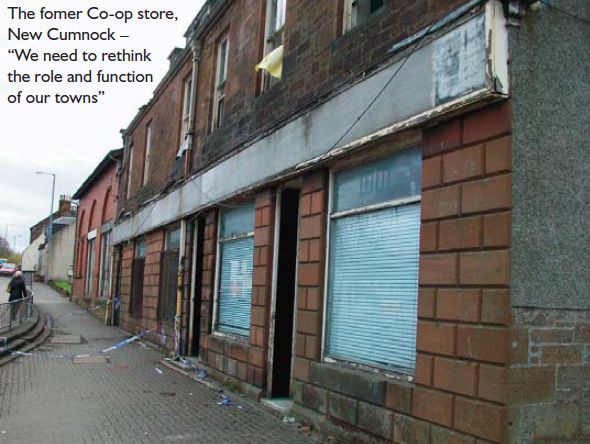SURF is a partner in the Scottish Towns Partnership (STP), which brings together a range of expert opinions to help inform government policy. STP was launched by Ross Martin at the Centre for Scottish Public Policy. In this feature, Ross outlines his view of the key questions we should be asking about the future of our towns and high streets, a central element of the Scottish Government’s Regeneration Discussion Paper.
Scotland’s towns are our most precious physical asset. OK, we like to see public art. We keep fit, derive educational benefit, recover from illness in signature buildings. We need footpaths, roads and rail to get around. We even occasionally appreciate the bland planning policy-driven open spaces in lego-like housing estates, but nowhere is quite like a town, or more specifically a town centre to make us feel at home.
Character and loss of vision
There is something fundamentally Scottish about our towns. It is hard to put one’s finger on it, but its there. It is perhaps the shape, the style or the stuff with which our places are made. Maybe it’s the way they look, or even feel. Scotland’s towns are special. If you were dropped, blindfold into a Scottish town and then allowed to look around, it wouldn’t take more than a few seconds for you to know which country you were in.
Even within our cities, our town centres are special, with that Scottish feel about them. They carry the self same characteristics that our provincial towns do. Whether they are flourishing, or in a state of decay and despair, Scotland’s towns are instantly recognisable, distinctive, places of collective character and individual identity. Scotland’s towns are places that we should be proud of. But are we really?
A tour of Scotland’s towns is enlightening and engaging, but at once depressing and debilitating. All across the country are fine examples of towns standing the test of time, whilst others have been allowed to let themselves go. We know what makes a town work, so why does it appear so difficult to recognise what doesn’t, and to stop doing it.

The fomer Co-op store,
New Cumnock
Scotland’s towns are a proud family with a rich heritage that is in danger of being lost, allowed to slowly decline and decay without the love, care and attention they so deserve.
Time to ask questions
We need to rethink the role and function of our towns. Scottish society has moved dramatically from the post-war homogeneity of mass production, with the private sector, and now even much of the public sector, shaping up accordingly. Far too many of our towns have yet to make that transition, either afraid to change, or lacking the imagination to map out a different future. In the current period of austerity, each and every town needs to ask itself some fundamental questions:
- What is my role?
- Where do I fit?
- Who am I serving?
- How can I do that better?
- Why am I here?
Is the role economic? If so, is it, should it or could it be driven by retail or some other enterprise? Can the current structure and lay-out support the identified role and function? Is the town centre too large, too small or flexible enough to cope with change? Is it accessible? To whom? Why does it look the way it does? Can it develop a strong sense of self or is there a competitive advantage in working with neighbouring towns collectively? Until we ask the questions, we won’t know the answers. It’s time to talk towns. Visit the Scotland’s Towns website at: www.scotlandstowns.org
